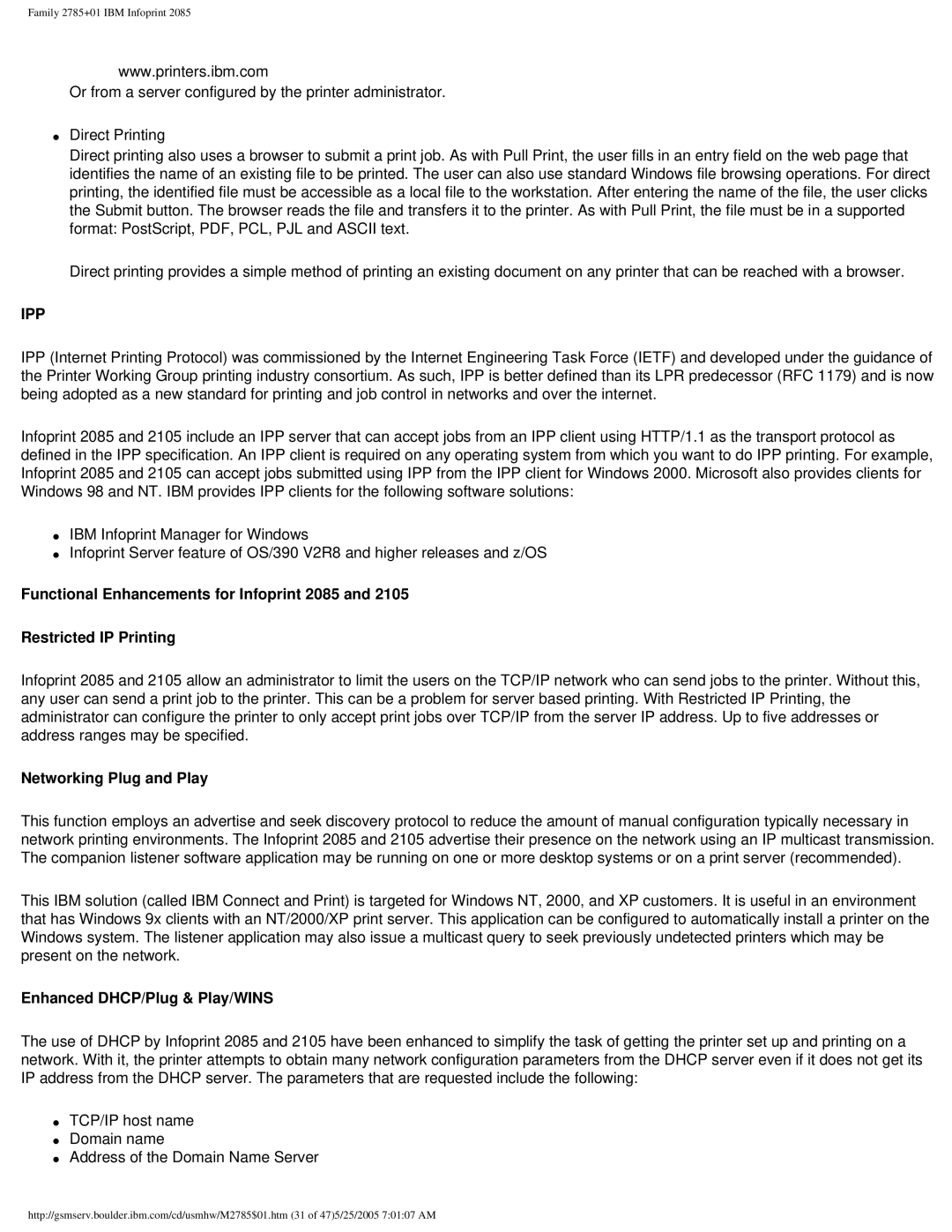Family 2785+01 IBM Infoprint 2085
www.printers.ibm.com
Or from a server configured by the printer administrator.
●Direct Printing
Direct printing also uses a browser to submit a print job. As with Pull Print, the user fills in an entry field on the web page that identifies the name of an existing file to be printed. The user can also use standard Windows file browsing operations. For direct printing, the identified file must be accessible as a local file to the workstation. After entering the name of the file, the user clicks the Submit button. The browser reads the file and transfers it to the printer. As with Pull Print, the file must be in a supported format: PostScript, PDF, PCL, PJL and ASCII text.
Direct printing provides a simple method of printing an existing document on any printer that can be reached with a browser.
IPP
IPP (Internet Printing Protocol) was commissioned by the Internet Engineering Task Force (IETF) and developed under the guidance of the Printer Working Group printing industry consortium. As such, IPP is better defined than its LPR predecessor (RFC 1179) and is now being adopted as a new standard for printing and job control in networks and over the internet.
Infoprint 2085 and 2105 include an IPP server that can accept jobs from an IPP client using HTTP/1.1 as the transport protocol as defined in the IPP specification. An IPP client is required on any operating system from which you want to do IPP printing. For example, Infoprint 2085 and 2105 can accept jobs submitted using IPP from the IPP client for Windows 2000. Microsoft also provides clients for Windows 98 and NT. IBM provides IPP clients for the following software solutions:
●IBM Infoprint Manager for Windows
●Infoprint Server feature of OS/390 V2R8 and higher releases and z/OS
Functional Enhancements for Infoprint 2085 and 2105
Restricted IP Printing
Infoprint 2085 and 2105 allow an administrator to limit the users on the TCP/IP network who can send jobs to the printer. Without this, any user can send a print job to the printer. This can be a problem for server based printing. With Restricted IP Printing, the administrator can configure the printer to only accept print jobs over TCP/IP from the server IP address. Up to five addresses or address ranges may be specified.
Networking Plug and Play
This function employs an advertise and seek discovery protocol to reduce the amount of manual configuration typically necessary in network printing environments. The Infoprint 2085 and 2105 advertise their presence on the network using an IP multicast transmission. The companion listener software application may be running on one or more desktop systems or on a print server (recommended).
This IBM solution (called IBM Connect and Print) is targeted for Windows NT, 2000, and XP customers. It is useful in an environment that has Windows 9x clients with an NT/2000/XP print server. This application can be configured to automatically install a printer on the Windows system. The listener application may also issue a multicast query to seek previously undetected printers which may be present on the network.
Enhanced DHCP/Plug & Play/WINS
The use of DHCP by Infoprint 2085 and 2105 have been enhanced to simplify the task of getting the printer set up and printing on a network. With it, the printer attempts to obtain many network configuration parameters from the DHCP server even if it does not get its IP address from the DHCP server. The parameters that are requested include the following:
●TCP/IP host name
●Domain name
●Address of the Domain Name Server
http://gsmserv.boulder.ibm.com/cd/usmhw/M2785$01.htm (31 of 47)5/25/2005 7:01:07 AM
